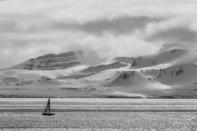
Nordic Seafarers
Starvation has prowled just beyond the light of the campfire and stalked through our settlements as long as humanity's ancestors have been walking upright. The Vikings, for one, had an unfortunate encounter with it. They had attempted to open up North America to trans-Atlantic trade.
These intrepid Nordic seafarers were aggressive colonisers during the peak of their culture - from about 800 to 1100 CE (Common Era). They set sail from their homeland of present-day Norway and Sweden and settled in Iceland, Greenland, parts of Scotland and Ireland, and even travelled as far as Newfoundland.
Their success was aided by a particularly balmy spell of post-glacial weather. Since the retreat of the continental ice sheets about 12 000 years ago, the planet has enjoyed a few comfortable warm spells.
The Medieval Warm Period between 900 to 1200 CE was one such time when temperatures were, on average, 1°C warmer than they are today. It was a pleasant time - pack ice retreated northwards, opening up safe travel for Viking ships, and longer growing seasons meant productive agriculture.
Viking farmers grew cereal crops in Iceland and Greenland and had enough surplus grain to sustain their livestock through the frigid winter months. And they traded with other parts of Europe for the items that they were unable to farm, their ships criss-crossing the Labrador and Norwegian Seas.
Then the Little Ice Age happened. Most argue that a decrease in sun spot activity cast the Northern Hemisphere into a chill. The impact on Europe was dramatic. A 1°C decrease in average temperatures cut the wheat-growing season by a third in Iceland, reducing cereal surpluses and making it difficult to keep cattle alive through winter. Once pack ice began drifting south again, Greenland was cut off from its European trade partners.
The strapping Nordic Vikings, who at the height of their achievement averaged 1.7 metres tall (which was pretty tall for the time), shrunk to under 1.52 metres tall. They were forced to abandon cereals, livestock died and they were left to rely solely on the sea for nutrition. Their population decline was dramatic, too. The last Vikings in Greenland were 'severely crippled, dwarf-like, twisted and diseased'.